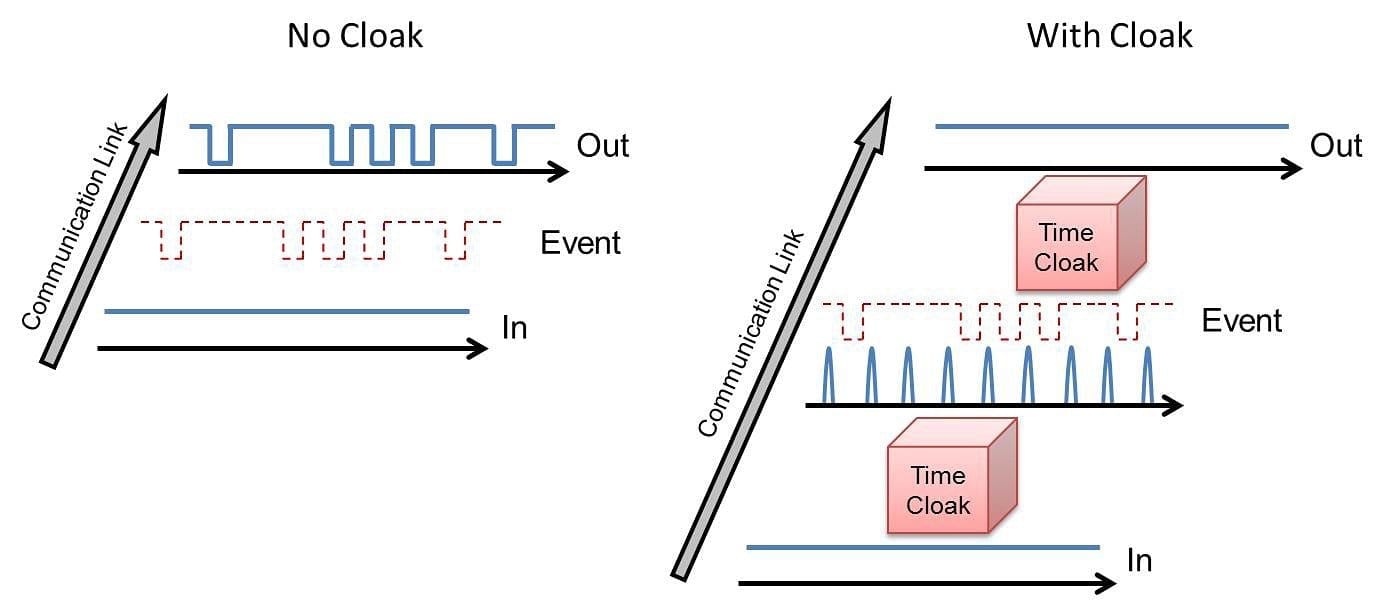
Researchers have demonstrated a method for “temporal cloaking” of optical communications, representing a potential tool to thwart would-be eavesdroppers and improve security for telecommunications.
“More work has to be done before this approach finds practical application, but it does use technology that could integrate smoothly into the existing telecommunications infrastructure,” said Purdue University graduate student Joseph Lukens, working with Andrew Weiner, the Scifres Family Distinguished Professor of Electrical and Computer Engineering.
Other researchers in 2012 invented temporal cloaking, but it cloaked only a tiny fraction – about a 10,000th of a percent – of the time available for sending data in optical communications. Now the Purdue researchers have increased that to about 46 percent, potentially making the concept practical for commercial applications.
While the previous research in temporal cloaking required the use of a complex, ultrafast-pulsing “femtosecond” laser, the Purdue researchers achieved the feat using off-the-shelf equipment commonly found in commercial optical communications.
Findings are detailed in a research paper appearing in the advance online publication of the journal Nature at 1 p.m. Eastern time Wednesday (June 5). The paper was authored by Lukens, senior research scientist Daniel E. Leaird and Weiner.
The technique works by manipulating the phase, or timing, of light pulses. The propagation of light can be likened to waves in the ocean. If one wave is going up and interacts with another wave that’s going down, they cancel each other and the light has zero intensity. The phase determines the level of interference between these waves.
“By letting them interfere with each other you are able to make them add up to a one or a zero,” Lukens said. “The zero is a hole where there is nothing.”
Any data in regions where the signal is zero would be cloaked.
Controlling phase allows the transmission of signals in ones and zeros to send data over optical fibers. A critical piece of hardware is a component called a phase modulator, which is commonly found in optical communications to modify signals.
In temporal cloaking, two phase modulators are used to first create the holes and two more to cover them up, making it look as though nothing was done to the signal.
“It’s a potentially higher level of security because it doesn’t even look like you are communicating,” Lukens said. “Eavesdroppers won’t realize the signal is cloaked because it looks like no signal is being sent.”
Such a technology also could find uses in the military, homeland security or law enforcement.
The Latest Bing News on:
Optical communications
- Optical illusion personality test: What you see first reveals your communication skills in the imageon May 4, 2024 at 8:55 am
where your direct communication style and decision-making skills can come into action. READ ALSO: Optical illusion challenge: This image reveals whether you are impatient or on the hunt for love If ...
- Nasa's psyche spacecraft sets new record in space communications by transmitting data from over 140 million mileson May 4, 2024 at 8:40 am
NASA's Deep Space Optical Communications (DSOC) technology, demonstrated aboard the Psyche spacecraft, has achieved a groundbreaking milestone by succ ...
- Optical Transport Network Equipment Market Set for Robust 9.2% CAGR Surge Over 2022-2032on May 2, 2024 at 7:33 pm
The optical transport network equipment market refers to the market for devices and solutions used in optical communication networks. OTN is a high-speed, high-capacity telecommunications network ...
- Optical illusion reveals key brain rule that governs consciousnesson May 2, 2024 at 6:44 am
A study of mice starts to unravel how the brain gets tricked by this kind of optical illusion, and it gives clues about how visual perception works.
- SkyWater and Lumotive Announce Qualification and Production Start for World’s First Commercially Available Optical Beamforming Chipon May 1, 2024 at 4:05 am
SkyWater Technology (NASDAQ: SKYT), the trusted technology realization partner, and Lumotive, a pioneer in optical semiconductor technology for 3D sensing, announced today that the companies have ...
- Data From the Void: NASA Receives Laser Communications From 140+ Million Miles Awayon April 30, 2024 at 1:18 am
NASA’s Deep Space Optical Communications experiment also interfaced with the Psyche spacecraft’s communication system for the first time, transmitting engineering data to Earth. Riding aboard NASA’s ...
- NASA: Deep space transmission strikes Earth from 140 million miles awayon April 29, 2024 at 8:59 pm
According to NASA, the Psyche spacecraft, a Deep Space Optical Communications technology demonstration, sent a copy of engineering data from over 140 million miles away. Per the organization ...
- NASA demonstrates space network speeds of up to 267 Mbps — Deep Space Optical Communications stretch beyond 140 million mileson April 29, 2024 at 12:25 pm
T he Jet Propulsion Laboratory at NASA has achieved network speeds of 267 Mbps past the distance between Earth and the sun with its new Deep Space Optical Communications (DSOC) system, which was ...
- Laser Communication Triumph: Psyche Mission Data Transmitted via Deep Space Optical Systemon April 26, 2024 at 4:50 pm
As NASA’s Psyche spacecraft travels towards its asteroid target, 16 Psyche, to examine this unique, all-metal world with its suite of scientific inst | Space ...
- NASA’s Psyche Optical Comms Demo Transmits From 140 Million Mileson April 26, 2024 at 9:34 am
NASA’s Psyche Optical Comms Demo Transmits From 140 Million Miles is published in Aerospace Daily & Defense Report, an Aviation Week Intelligence Network (AWIN) Market Briefing and is included with ...
The Latest Google Headlines on:
Optical communications
[google_news title=”” keyword=”optical communications” num_posts=”10″ blurb_length=”0″ show_thumb=”left”]
The Latest Bing News on:
Secure optical communications
- Coherent (COHR) Q3 2024 Earnings Call Transcripton May 7, 2024 at 11:00 am
Welcome to the Coherent Corp. fiscal year '24 third-quarter earnings call. At this time, all participants are in a listen-only mode. After the speakers' presentation, there will be a ...
- Breaking the Scaling Limits: New Ultralow-noise Superconducting Camera for Exoplanet Searcheson May 7, 2024 at 9:18 am
When imaging faint objects such as distant stars or exoplanets, capturing every last bit of light is crucial to get the most out of a scientific mission. These cameras must be extremely low-noise, and ...
- EQS-News: Mynaric selected by Rocket Lab for Space Development Agency’s Tranche 2 Transport Layer – Beta Programon May 7, 2024 at 7:00 am
Mynaric’sCONDOR family of optical communications terminalsis specifically designed ... allowing for ultra-high data rates and secure, long-distance data transmission between moving objects for ...
- Rocket Lab Selects Subcontractors to Support SDA Satellite Constellation Developmenton May 6, 2024 at 1:36 pm
Rocket Lab USA, Inc. (Nasdaq: RKLB) ("Rocket Lab" or "the Company"), a global leader in launch services and space systems, today announced it has completed the selection of subcontractors to provide ...
- Laser Transmission Explained: What It Means For Transmitting Data During Space Explorationon May 2, 2024 at 7:53 am
Some of the earliest spaceflights have been facilitated via radio communication with Earth, but laser transmission is the modern evolution of space comms.
- Unveiling a new quantum frontier: Frequency-domain entanglementon April 26, 2024 at 9:03 am
Scientists have introduced a form of quantum entanglement known as frequency-domain photon number-path entanglement. This advance in quantum physics involves an innovative tool called a frequency beam ...
- Kepler Partners to Develop In-Space Optical Communications Network for HydRONon April 10, 2024 at 10:01 am
TORONTO, April 10, 2024 (GLOBE NEWSWIRE) -- Kepler Communications ... with a state-of-the-art optical network architecture that gives European and Canadian forces secure access to spacecraft ...
- Kepler Partners to Develop In-Space Optical Communications Network for HydRONon April 10, 2024 at 6:00 am
TORONTO, April 10, 2024 (GLOBE NEWSWIRE) -- Kepler Communications ... with a state-of-the-art optical network architecture that gives European and Canadian forces secure access to spacecraft data with ...
- 100 kilometers of quantum-encrypted transferon April 2, 2024 at 7:34 am
Encryption combines data with a secure key distributed between sender ... is that we can build a system that resembles what optical communication already relies on." The backbone of the internet ...
- Quantum Communication: Harnessing the Power of Quantum Physics for Secure Data Transmissionon March 21, 2024 at 2:50 am
Quantum networks are envisioned as the future of secure communication infrastructure ... exploring various physical platforms such as optical fibers, free-space links, and satellite-based systems.
The Latest Google Headlines on:
Secure optical communications
[google_news title=”” keyword=”secure optical communications” num_posts=”10″ blurb_length=”0″ show_thumb=”left”]










